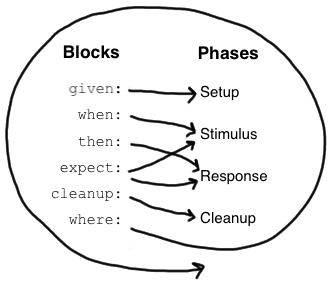Spock測試套件入門
阿新 • • 發佈:2020-09-19
[TOC]
### Spock測試套件
Spock套件基於一個單元測試框架,它有比junit更為簡潔高效的測試語法。
### 核心概念
#### 整體認識
Spock中一個單元測試類名叫Specification。所有的單元測試類,都需要繼承Specification
```
class MyFirstSpecification extends Specification {
// fields
// fixture methods
// feature methods
// helper methods
}
```
對於spock來說,Specification代表了一個軟體、應用、類的使用規範,其中的所有單元測試方法,被稱為feature,即功能。
一個feature method的執行邏輯大概是如下幾步:
1. setup 設定該功能的前置配置
2. stimulus 提供一個輸入,觸發該功能
3. response 描述你期望該功能的返回值
4. cleanup 清理功能的前置配置
所以,**對spock來說,一個單元測試,其實是這個軟體應用提供的功能使用規範,這個規範中提供了每個功能的使用說明書,輸入什麼,會得到什麼**,大體是按這個看法,去寫單元測試的。
#### 前置、後置
就像junit一樣,我們可以對整個單元測試類做一些前置,並清理。也可以對每個單元測試的方法做一些前置後清理。
其跟Junit的類比關係為
```
setupSpec 對應 @BeforeClass
setup 對應 @Before
cleanup 對應 @After
cleanupSpec 對應 @AfterClass
```
同時由於Spock的單元測試本身是會整合Specification 父類的,所以父類中的前置、後置方法也會被呼叫,不過不用顯示呼叫,會自動呼叫。
一個測試功能方法執行時,其整體的執行順序為:
```
super.setupSpec
sub.setupSpec
super.setup
sub.setup
**feature method
sub.cleanup
super.cleanup
sub.cleanupSpec
super.cleanupSpec
```
### 同junit的類比

### Feature 方法
#### blocks
feature的具體寫法有很多的block組成,這些block對應的feature方法本身的四個階段(setup, stimulus, reponse, cleanup) 。每個block對應階段示意圖

#### 典型的用法
```
def '測試++'(){
given:
def x = 5
when: def result = calculateService.plusPlus(x)
then: result == 6
}
```
- given也可以寫成setup,feature方法裡的given其實跟外面的setup方法功能一樣,都是做測試功能的前置設定。只是單獨的setup方法,是用來寫對每個測試feature都有用的測試。只跟當前feature相關的設定,請放在feature方法內的given標籤
- when 標籤用來實際呼叫想要測試的feature
- then 中對when的呼叫返回進行結果驗證,這裡不需要寫斷言,直接寫表示式就是斷言
#### 異常condition
then中的斷言在spock中叫condition。比如Java中的Stack在沒有元素時,進行Popup,則會EmptyStackException異常。我們期望它確實會丟擲這個異常,那麼寫法如下
```
def '異常2'() {
given:
def stack = new Stack()
when:
def result = stack.pop()
then:
EmptyStackException e = thrown()
}
```
它並不會丟擲EmptyStackException,我們要測試這個預期的話,程式碼如下:
```
def '異常2'() {
given:
def stack = new Stack()
stack.push("hello world")
when:
stack.pop()
then:
EmptyStackException e = notThrown()
}
```
#### then和expect的區別
前面說了when block用來呼叫,then用來判斷預期結果。但有的時候,我們的呼叫和預期判斷並不複雜,那麼可以用expect將兩者合在一起,比如以下兩段程式碼等價
```
when:
def x = Math.max(1, 2)
then:
x == 2
```
```
expect:
Math.max(1, 2) == 2
```
#### cleanup block的用法
```
def 'cleanup'() {
given:
def file = new File("/some/path")
file.createNewFile()
// ...
cleanup:
file.delete()
}
```
用於清理feature測試執行後的一些設定,比如開啟的檔案連結。該操作即便測試的feature出異常,依然會被呼叫
同樣,如果多個測試feature都需要這個cleanup.那麼建議將cleanup的資源提到setup方法中,並在cleanup方法中去清理
#### 測試用例中的文字描述
為了讓單元測試可讀性更高,可以將測試方法中每一部分用文字進行描述,多個描述可以用and來串聯
```
def '異常2'() {
given:'設定stack物件'
def stack = new Stack()
and:'其它變數設施'
stack.push('hello world')
when:'從stack中彈出元素'
def result = stack.pop()
then:'預期會出現的異常'
EmptyStackException e = thrown()
}
```
### Extension
spock通過標註來擴充單元測試的功能
`@Timeout`指定一個測試方法,或一個設定方法最長可以執行的時間,用於對效能有要求的測試
`@Ignore`用於忽略當前的測試方法
`@IgnoreRest`忽略除當前方法外的所有方法,用於想快速的測一個方法
`@FailsWith` 跟exception condition類似
### 資料驅動測試
#### 資料表
對於有些功能邏輯,其程式碼是一樣的,只是需要測試不同輸入值。按照先前的介紹,最簡潔的寫法為:
```
def "maximum of two numbers1"() {
expect:
// exercise math method for a few different inputs
Math.max(1, 3) == 3
Math.max(7, 4) == 4
Math.max(0, 0) == 1
}
```
缺點:
1. Math.max程式碼需要手動呼叫三次
2. 第二行出錯後,第三行不會被執行
3. 資料和程式碼耦合在一起,不方便資料從其它地方獨立準備
所以spock引入了資料表的概念,將測試資料和程式碼分開。典型例項如下:
```
class MathSpec extends Specification {
def "maximum of two numbers"() {
expect:
Math.max(a, b) == c
where:
a | b || c
1 | 3 || 3
7 | 4 || 7
0 | 0 || 0
}
}
```
- where語句中,定義資料表。第一行是表頭,定義這一列所屬的變數。
- 實際程式碼呼叫,只需要呼叫一次。程式碼中的變數跟資料表中的變數必須一一對應
- 看似一個方法,實際上執行時,spock會根據資料表中的行數,迴圈迭代執行程式碼。每一行都是獨立於其餘行執行,所以有setup和cleanup塊,對每一個行的都會重複執行一次
- 並且某一行的資料出錯,並不影響其餘行的執行
#### 另外的寫法
```
def "maximum of two numbers"(int a, int b ,int c) {
expect:
Math.max(a, b) == c
where:
a | b | c
1 | 3 | 3
7 | 4 | 4
0 | 0 | 1
}
```
- 變數可以在方法引數中宣告,但沒必要
- 資料表可以全部用一個豎線來分割,但無法像兩個豎線一樣清晰的分割輸入和輸出
#### 更清晰的測試結果展示
```
class MathSpec extends Specification {
def "maximum of two numbers"() {
expect:
Math.max(a, b) == c
where:
a | b || c
1 | 3 || 3
7 | 4 || 4
0 | 0 || 1
}
}
```
以上測試程式碼,資料表中的後兩行會執行失敗。但從測試結果面板中,不能很好的看到詳細結果

使用`@Unroll`可以將每個迭代的執行結果輸出

可以看到面板中實際輸出的文字為測試方法的名稱。如果像在輸出中加上輸入輸出的變數,來詳細展示每個迭代,可以在方法名中使用佔位符`#variable`來引用變數的值。舉例如下:
```
@Unroll
def "maximum of #a and #b is #c"() {
expect:
Math.max(a, b) == c
where:
a | b || c
1 | 3 || 3
7 | 4 || 4
0 | 0 || 1
}
```

#### 更豐富的資料準備方式
前面的資料表顯示的將資料以表格的形式寫出來。實際上,資料在where block中的準備還有其它多種方式。
```
where:
a << [1, 7, 0]
b << [3, 4, 0]
c << [3, 7, 0]
```
從資料庫中查詢
```
@Shared sql = Sql.newInstance("jdbc:h2:mem:", "org.h2.Driver")
def "maximum of two numbers"() {
expect:
Math.max(a, b) == c
where:
[a, b, c] << sql.rows("select a, b, c from maxdata")
}
```
使用groovy程式碼賦值
```
where:
a = 3
b = Math.random() * 100
c = a > b ? a : b
```
以上幾種方式可以混搭。
其中方法名也可以以豐富的表示式引用where block中的變數
```
def "person is #person.age years old"() {
...
where:
person << [new Person(age: 14, name: 'Phil Cole')]
lastName = person.name.split(' ')[1]
}
```
### 基於互動的測試(Interaction Based Testing)
有的時候,我們測試的功能,需要依賴另外的collaborators來測試。這種涉及到多個執行單元之間的互動,叫做互動測試
比如:
```
class Publisher {
List subscribers = []
int messageCount = 0
void send(String message){
subscribers*.receive(message)
messageCount++
}
}
interface Subscriber {
void receive(String message)
}
```
我們想測Publisher,但Publisher有個功能是是發訊息給所有的Subscriber。要想測試Publisher的傳送功能確實ok,那麼需要測試Subscriber的確能收到訊息。
使用一個實際的Subscriber實現固然能實現這個測試。但對具體的Subscriber實現造成了依賴,這裡需要Mock。使用spock的測試用例如下:
```
class PublisherTest extends Specification{
Publisher publisher = new Publisher()
Subscriber subscriber = Mock()
Subscriber subscriber2 = Mock() //建立依賴的Subscriber Mock
def setup() {
publisher.subscribers << subscriber // << is a Groovy shorthand for List.add()
publisher.subscribers << subscriber2
}
def "should send messages to all subscribers"() {
when:
publisher.send("hello") //呼叫publisher的方法
then:
1*subscriber.receive("hello") //期望subscriber的receive方法能被呼叫一次
1*subscriber2.receive("hello")//期望subscriber1的receive方法能被呼叫一次
}
}
```
以上程式碼的目的是通過mock來測試當Publisher的send的方法被執行時,且執行引數是'hello'時,subscriber的receive方法一定能被呼叫,且入參也為‘hello’
#### 對依賴Mock的呼叫期望,其結構如下
```
1 * subscriber.receive("hello")
| | | |
| | | argument constraint
| | method constraint
| target constraint
cardinality
```
**cardinality**
定義右邊期望方法執行的次數,這裡是期望執行一次,可能的寫法有如下:
```
1 * subscriber.receive("hello") // exactly one call
0 * subscriber.receive("hello") // zero calls
(1..3) * subscriber.receive("hello") // between one and three calls (inclusive)
(1.._) * subscriber.receive("hello") // at least one call
(_..3) * subscriber.receive("hello") // at most three calls
_ * subscriber.receive("hello") // any number of calls, including zero
```
**target constraint**
定義被依賴的物件。可能的寫法如下
```
1 * subscriber.receive("hello") // a call to 'subscriber'
1 * _.receive("hello") // a call to any mock object
```
**Method Constraint**
定義在上述物件上期望被呼叫的方法,可能的寫法如下:
```
1 * subscriber.receive("hello") // a method named 'receive'
1 * subscriber./r.*e/("hello") // a method whose name matches the given regular expression
// (here: method name starts with 'r' and ends in 'e')
```
**Argument Constraints**
對被呼叫方法,期望的入參進行定義。可能寫法如下:
```
1 * subscriber.receive("hello") // an argument that is equal to the String "hello"
1 * subscriber.receive(!"hello") // an argument that is unequal to the String "hello"
1 * subscriber.receive() // the empty argument list (would never match in our example)
1 * subscriber.receive(_) // any single argument (including null)
1 * subscriber.receive(*_) // any argument list (including the empty argument list)
1 * subscriber.receive(!null) // any non-null argument
1 * subscriber.receive(_ as String) // any non-null argument that is-a String
1 * subscriber.receive(endsWith("lo")) // any non-null argument that is-a String
1 * subscriber.receive({ it.size() >
